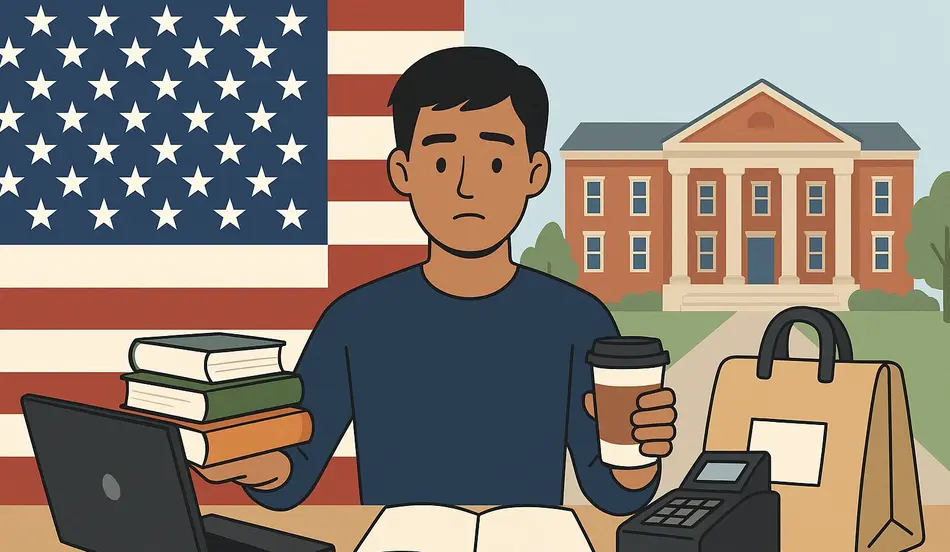International student struggles in the USA expose the harsh reality of balancing part-time jobs with academic responsibilities while navigating complex visa restrictions and financial pressures. The story of Priya, a 22-year-old business administration student from Hyderabad, illustrates how the very rules designed to protect international students can become traps that force them into impossible choices between survival and compliance.
The 20-hour work limit for F1 visa holders, while intended to ensure students focus on their studies, often creates more problems than it solves. When family financial support dwindles due to currency fluctuations, medical emergencies, or economic downturns, international students find themselves caught between legal boundaries and basic survival needs.
The struggle goes beyond simple financial hardship. It encompasses the psychological toll of being thousands of miles from home, the pressure of family expectations, and the constant fear of losing visa status. These students must navigate complex bureaucratic systems while managing academic performance, often with limited support networks and cultural barriers.
The reality is that many international students face situations where the 20-hour work limit becomes a barrier to basic survival, forcing them to choose between following the law and meeting their essential needs. This creates a moral and practical dilemma that few domestic students ever experience.
Table of Contents
The Financial Reality: When Support Systems Fail
International students often arrive in the USA with carefully calculated budgets based on stable exchange rates and family financial planning. However, currency fluctuations, family emergencies, or economic downturns can quickly turn a manageable situation into a crisis.
Priya’s experience illustrates this perfectly. Her family had saved, borrowed, and even sold land to fund her education, but when the rupee weakened against the dollar, their carefully planned budget became insufficient. The numbers in her parents’ bank account didn’t change, but the cost of her education in dollars increased dramatically.
The 20-hour work limit, while well-intentioned, often proves inadequate for covering basic living expenses, let alone tuition costs. Campus jobs typically pay minimum wage, and even at maximum hours, the income barely covers rent and food, leaving little for tuition or unexpected expenses.
This creates a situation where international students must find creative solutions within legal boundaries or risk their visa status by working off-campus without authorization. The choice between following the law and meeting basic needs becomes a daily struggle.
The Financial Reality for International Students
Currency shifts, limited work hours, and high living costs leave many international students struggling to make ends meet. Employers can help by offering flexible, fair opportunities that support education and stability. Post your job on WhatJobs today and connect with students eager to contribute while pursuing their dreams.
Post a Job Free for 30 Days →The Legal Labyrinth: Navigating Visa Restrictions
The F1 visa system creates a complex web of restrictions that international students must navigate while dealing with financial pressures. The 20-hour work limit is just one of many constraints that can feel overwhelming when resources are scarce.
Legal work options for international students include on-campus employment, Curricular Practical Training (CPT) for internships related to their major, and Optional Practical Training (OPT) after graduation. However, each option comes with specific requirements, paperwork, and time constraints that may not align with immediate financial needs.
The bureaucratic process for obtaining work authorization can be slow and complex, requiring proof of course enrollment, supervisor letters, curriculum descriptions, and various signatures. For students in crisis, this process may be too slow to address immediate financial needs.
The fear of losing visa status creates additional pressure, as any violation of work restrictions can result in deportation and the loss of everything the student and their family have invested in their education.
The Psychological Toll: Isolation and Pressure
The financial struggles of international students are compounded by psychological pressures that domestic students rarely experience. The weight of family expectations, the fear of disappointing loved ones who have made significant sacrifices, and the isolation of being far from home create additional stress.
Priya’s story reveals the emotional complexity of these situations. Her parents’ sacrifices, including her mother cutting back on medication and her father working extra hours, added to her sense of responsibility and guilt. The pressure to succeed becomes not just personal but familial.
The constant calculation of expenses, the fear of running out of money, and the stress of maintaining academic performance while working maximum hours create a perfect storm of anxiety and pressure that can impact both mental health and academic success.
The isolation is particularly acute for international students who may not have strong support networks in the USA and may be reluctant to share their struggles with family members who are already making sacrifices to support their education.
The Community Response: Building Support Networks
Despite the challenges, many international students find strength in community support and creative problem-solving. Student organizations, peer networks, and campus resources can provide crucial assistance during difficult times.
Priya’s experience highlights the importance of reaching out for help and building support networks. Through her international students group, she found practical advice, emotional support, and creative solutions that helped her navigate her financial crisis without violating visa restrictions.
Campus resources, including financial aid offices, emergency funds, and student hardship programs, can provide crucial assistance for students in crisis. However, these resources are often underutilized because students may not know they exist or may be reluctant to ask for help.
The development of peer support networks, including cooperative arrangements where students can exchange services within legal boundaries, demonstrates the resilience and creativity of international students facing financial challenges.
Supporting International Students
Balancing studies with part-time jobs is one of the biggest challenges for international students in the U.S. Employers can make a difference by offering flexible opportunities that support education and career growth. Post your job on WhatJobs today and connect with international students eager to work and contribute.
Post a Job Free for 30 Days →The Ethical Dilemma: Following the Law vs. Survival
The core ethical dilemma facing international students is the choice between following visa restrictions and meeting basic survival needs. This choice is particularly difficult when legal options are slow or insufficient to address immediate financial crises.
The temptation to work off-campus without authorization is understandable when students face eviction, hunger, or the inability to pay tuition. However, the consequences of getting caught can be severe, including deportation and the loss of everything they’ve worked to achieve.
This dilemma highlights the need for more flexible and responsive support systems for international students. The current system often forces students to choose between following the law and meeting basic needs, which is an impossible choice that no student should have to make.
The solution requires both individual resilience and systemic change, including more emergency funding, faster authorization processes, and clearer guidance for students in crisis.
Frequently Asked Questions
International student struggles in the USA – what are the main challenges?
International student struggles in the USA include the 20-hour work limit creating financial crises, currency fluctuations affecting family support, complex visa restrictions, and the choice between following the law and meeting basic survival needs.
How does the 20-hour work limit affect international students?
The 20-hour work limit often proves inadequate for covering basic living expenses and tuition, forcing students to choose between following visa restrictions and meeting essential needs, creating impossible moral and practical dilemmas.
What legal work options are available for international students?
Legal options include on-campus employment up to 20 hours, Curricular Practical Training (CPT) for major-related internships, and Optional Practical Training (OPT) after graduation, but each has specific requirements and time constraints.
What happens if international students work off-campus without authorization?
Working off-campus without authorization risks deportation and loss of visa status, which means losing everything the student and their family have invested in their education, making it a high-stakes decision.
How can international students find help during financial crises?
Students can access campus resources like financial aid offices and emergency funds, build support networks through student organizations, explore creative legal solutions like tutoring, and ask for help without shame.
What systemic changes are needed to help international students?
Students can access campus resources like financial aid offices and emergency funds, build support networks through student organizations, explore creative legal solutions like tutoring, and ask for help without shame.
A Real-World Example: The Business Student’s Journey
Maria Rodriguez, a graduate student in international business from Mexico, faced similar challenges to Priya’s story. “When my father lost his job back home, our family’s financial situation changed overnight,” she explains. “Suddenly, the 20-hour work limit felt like a prison sentence.”
Maria’s experience highlights the emotional complexity of these situations. “I felt guilty asking my family for more money when they were already struggling,” she says. “But I also couldn’t work more hours legally, and I was terrified of losing my visa status.”
The solution required creativity and community support. “I started tutoring other international students in Spanish and business courses,” Maria explains. “I also joined a student cooperative where we exchanged services – I helped with resume writing, and others helped me with research and proofreading.”
Maria’s experience also taught her the importance of advocacy. “I realized that many students were facing similar challenges, so I started working with the international students office to create more resources and support programs,” she says.
The experience transformed Maria’s career goals. “I decided to focus on international development and education policy,” she explains. “I want to help create better systems for international students so they don’t have to face these impossible choices.”
Maria’s advice to other international students reflects the lessons she learned. “Don’t be afraid to ask for help, and don’t try to solve everything alone,” she says. “Build your community, explore all your options, and remember that your struggles are valid and your choices matter.”
Maria’s story demonstrates that while the challenges are real and significant, they can also lead to personal growth, community building, and a commitment to creating positive change for future students.
Don’t Face These Struggles Alone
The international student struggles in the USA reveal a system that often fails to provide adequate support for students who are already facing significant challenges. The 20-hour work limit, while well-intentioned, can become a barrier to basic survival rather than a protection for academic focus.
The solution requires both individual resilience and systemic change. Students must learn to ask for help, build support networks, and explore creative solutions within legal boundaries. At the same time, universities, government agencies, and student organizations must work together to create more supportive and flexible systems.
The stories of students like Priya and Maria demonstrate that these challenges can be overcome, but they require courage, creativity, and community support. No student should have to choose between following the law and meeting basic survival needs.
The time for change is now. International students deserve better support systems, more flexible work options, and clearer pathways to assistance during financial crises. Their success is not just personal but contributes to the diversity and strength of American higher education.




